Study: Administer cefuroxime antimicrobial prophylaxis within 60 minutes prior to incision
Key takeaways:
- Cefuroxime antimicrobial prophylaxis should be administered within 60 minutes prior to incision to reduce risk for surgical site infection.
- Administration within 10 to 25 minutes before incision is ideal.
Cefuroxime surgical antimicrobial prophylaxis should be administered within 60 minutes prior to incision to maximize risk reduction for surgical site infection in patients undergoing surgery, according to published results.
Rami Sommerstein, MD, and colleagues analyzed 222,439 patients (mean age, 65.7 years; 46.8% men) aged older than 18 years who underwent surgery between 2009 and 2020 and received cefuroxime surgical antimicrobial prophylaxis (SAP). Researchers analyzed three cohorts: 27,207 patients who received SAP between 61 and 120 minutes before incision, 118,004 patients who received SAP between 31 and 60 minutes before incision and 77,228 patients who received SAP between 0 and 30 minutes before incision.

According to the study, surgery types included hernia repair, total knee arthroplasty, total hip arthroplasty, cardiac surgery, laminectomy, spondylodesis, colon surgery, cholecystectomy, cesarean delivery, gastric bypass or hysterectomy. Researchers noted arthroplasty procedures accounted for 55.4% of all surgeries.
Overall, researchers found surgical site infection (SSI) in 2.4% of patients (n = 5,355). Compared with patients in the 61- to 120-minute cohort, patients in the 31- to 60-minutes cohort and patients in the 0- to 30-minute cohort had “significantly” reduced odds of SSI. They noted patients who received SAP administration 10 to 25 minutes prior to incision had the lowest risk for SSI.
“Our results suggest that cefuroxime SAP should be administered within 60 minutes prior to incision to reduce SSI risk,” the researchers wrote. “The subgroup analysis suggests a window ideally between 10 and 25 minutes before incision, which was associated with the lowest risk of SSI.”
